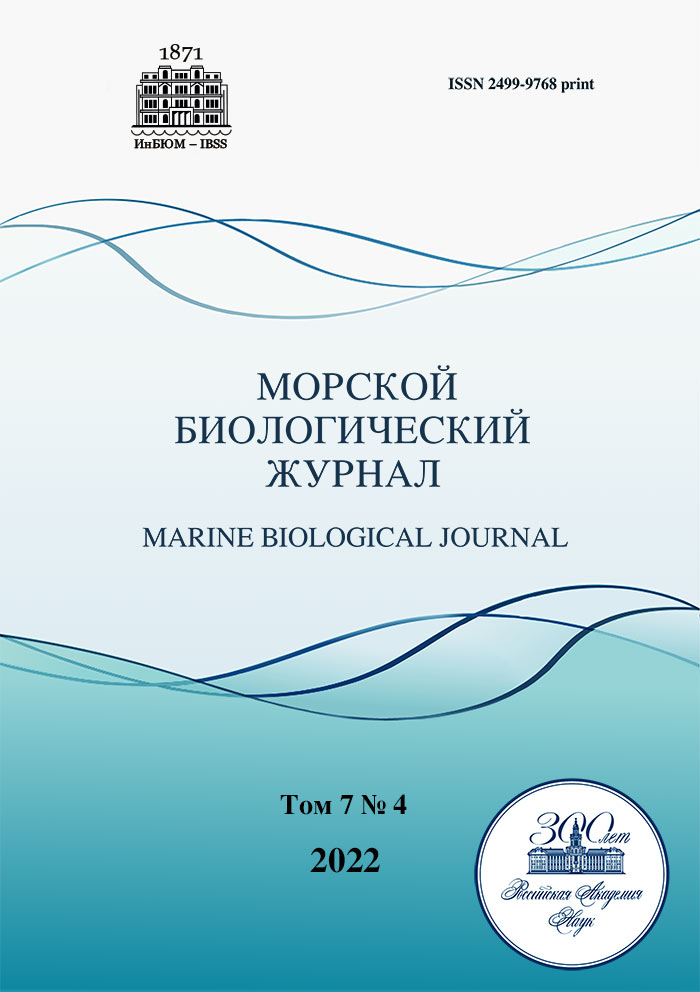Computer methods for determining Mnemiopsis leidyi motility characteristics
##plugins.themes.ibsscustom.article.main##
##plugins.themes.ibsscustom.article.details##
Abstract
The paper considers capacities of common computer programs for analyzing the behavioral reactions to light of ctenophores, marine planktonic animals, under laboratory conditions. We showed that most image analysis programs do not automatically determine body contours of translucent objects, such as ctenophores. We developed a new method for determining basic motility characteristics of Mnemiopsis leidyi using ImageJ, Davinci Resolve video filters, and scripts written by the us. The developed method allows automatic calculating of such parameters as average and maximum speed, changes in direction of movement (locomotion vectors), and the percentage of time animals spend in certain regions of interest (ROI). The average speed of ctenophore movement was estimated in millimeter scale with high precision. The method is applicable for studying the behavior of various translucent marine animals. Computer scripts are available by request from the authors.
Authors
References
Alsaif K. I., Hamid R. H. Flora Zatoki Gdańskiej i wód przyleglych (Bałtyk Poludniowy). 6. Zielenice – Chlorophyta (red algae & brown algae). International Journal of Computer Applications, 2018, vol. 179, no. 16, pp. 10–13.
Baiandina Iu. S., Khanaychenko A. N. Optimization of the method for determining the motility characteristics of fish spermatozoa using ImageJ software and Excel macros. Journal of Ichthyology, 2019, vol. 59, iss. 1, pp. 127–130. https://doi.org/10.1134/S0032945219010016
Baiandina Iu. S., Kirin M. P., Krivenko O. V. Black Sea Mnemiopsis leidyi (Ctenophora) adult locomotion and light-induced behavior in laboratory experiments. Journal of Sea Research, 2022, vol. 180, art. no. 102152 (7 p.). https://doi.org/10.1016/j.seares.2021.102152
Franco-Restrepo J. E., Forero D. A., Vargas R. A. A review of freely available, open-source software for the automated analysis of the behavior of adult zebrafish. Zebrafish, 2019, vol. 16, no. 3, pp. 223–232. https://doi.org/10.1089/zeb.2018.1662
Gulyás M., Bencsik N., Pusztai S., Liliom H., Schlett K. AnimalTracker: An ImageJ-based tracking API to create a customized behaviour analyser program. Neuroinformatics, 2016, vol. 14, iss. 4, pp. 479–481. https://doi.org/10.1007/s12021-016-9303-z
Haney J. F. Diel patterns of zooplankton behavior. Bulletin of Marine Science, 1988, vol. 43, no. 3, pp. 583–603.
Haraldsson M., Båmstedt U., Tiselius P., Titelman J., Aksnes D. L. Evidence of diel vertical migration in Mnemiopsis leidyi. PLoS ONE, 2014, vol. 9, iss. 1, art. no. e86595 (10 p.). https://doi.org/10.1371/journal.pone.0086595
Hays G. C. A review of the adaptive significance and ecosystem consequences of zooplankton diel vertical migrations. Hydrobiologia, 2003, vol. 503, iss. 1–3, pp. 163–170. https://doi.org/10.1023/B:HYDR.0000008476.23617.b0
Kideys A., Romanova Z. Distribution of gelatinous macrozooplankton in the southern Black Sea during 1996–1999. Marine Biology, 2001, vol. 139, iss. 3, pp. 535–547. https://doi.org/10.1007/s002270100602
Larsen M. H., Johnsson J. I., Winberg S., Wilson A. D. M., Hammenstig D., Thörnqvist P.-O., Midwood J. D., Aarestrup K., Höglund E. Effects of emergence time and early social rearing environment on behaviour of Atlantic salmon: Consequences for juvenile fitness and smolt migration. PLoS ONE, 2015, vol. 10, iss. 3, art. no. e0119127 (17 p.). https://doi.org/10.1371/journal.pone.0119127
Mutlu E. Distribution and abundance of ctenophores and their zooplankton food in the Black Sea. II. Mnemiopsis leidyi. Marine Biology, 1999, vol. 135, iss. 4, pp. 603–613. https://doi.org/10.1007/s002270050661
Nussbaum-Krammer C. I., Neto M. F., Brielmann R. M., Pedersen J. S., Morimoto R. I. Investigating the spreading and toxicity of prion-like proteins using the metazoan model organism C. elegans. Journal of Visualized Experiments, 2015, vol. 95, art. no. e52321 (15 p.). https://doi.org/10.3791/52321
Ringelberg J. Changes in light intensity and diel vertical migration: A comparison of marine and freshwater environments. Journal of the Marine Biological Association of the United Kingdom, 1995, vol. 75, iss. 1, pp. 15–25. https://doi.org/10.1017/S0025315400015162
Ringelberg J. A. Decision-Making Mechanism. In: Ringelberg J. A. Diel Vertical Migration of Zooplankton in Lakes and Oceans. Causal Explanations and Adaptive Significances. Dordrecht ; Heidelberg ; London ; New York : Springer, 2009, pp. 49–70. https://doi.org/10.1007/978-90-481-3093-1_4
Ruppert E. E., Fox R. S., Barnes R. D. Invertebrate Zoology: A Functional Evolutionary Approach. 7th edition. Belmont, CA : Thomson-Brooks/Cole, 2004, 963 p.
Samson A. L., Ju L., Kim H. A., Zhang Sh. R., Lee J. A. A., Sturgeon Sh. A., Sobey Ch. G., Jackson Sh. P., Schoenwaelder S. M. MouseMove: An open source program for semi-automated analysis of movement and cognitive testing in rodents. Scientific Reports, 2015, vol. 5, art. no. 16171 (11 p.). https://doi.org/10.1038/srep16171
Schnitzler Ch. E., Pang K., Powers M. L., Reitzel A. M., Ryan J. F., Simmons D., Tada T., Park M., Gupta J., Brooks Sh. Y., Blakesley R. W., Yokoyama Sh., Haddock S. H. D., Martindale M. Q., Baxevanis A. D. Genomic organization, evolution, and expression of photoprotein and opsin genes in Mnemiopsis leidyi: A new view of ctenophore photocytes. BMC Biology, 2012, vol. 10, art. no. 107 (26 p.). https://doi.org/10.1186/1741-7007-10-107
Tamm S. L. Cilia and the life of ctenophores. Invertebrate Biology, 2014, vol. 133, iss. 1, pp. 1–46. https://doi.org/10.1111/ivb.12042
Wilson-Leedy J. G., Ingermann R. L. Development of a novel CASA system based on open source software for characterization of zebrafish sperm motility parameters. Theriogenology, 2007, vol. 67, iss. 3, pp. 661–672. https://doi.org/10.1016/j.theriogenology.2006.10.003
Zaika V. E., Sergeeva N. G. Diurnal changes of the population structure and vertical distribution of Mnemiopsis mccradyi Mayer (Ctenophora) in the Black Sea. Gidrobiologicheskii zhurnal, 1991, vol. 27, iss. 2, pp. 15–19.


 Google Scholar
Google Scholar



